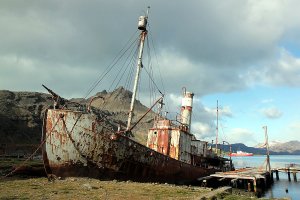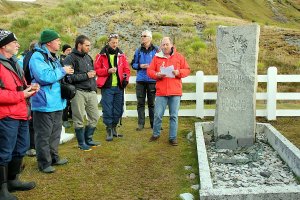Arto's Blog
| « Stop, sit down and look around | Green and lively South Georgia » |
Whalers and explorers
Posted: 2015-09-17 22:58:00, Categories: Travel, Antarctica, Sailing, South Georgia, 752 words (permalink)South Georgia has not always been the kind of nature sanctuary we were
visiting. It used to be seal hunting grounds at the end of the 18th
and during the 19th century, and a hub of the whaling industry until
1960s. Especially from the whaling period there are many old
buildings and other constructions. They are nowadays slowly
disintegrating due to lack of maintenance, but will most likely
remain for hundreds of years. Now under protection, seal populations
have recovered well from near extinction. Whales have a much longer
breeding cycle and are still a rare sight in South Georgian waters.
Due to the facilities which were manned all year round, South
Georgia was also an important starting point for Antarctic
exploration. Explorers would come in with their ships and get
supplies for the last time before sailing south towards the
unknown. The most famous of them was Sir Ernest Shackleton, whose
heritage is kept alive on the island by the South Georgia Heritage
Trust. The Trust also maintains a whaling museum and runs various
projects in order to preserve the historical sites and to protect
the wildlife on the island.
We started our Museum visit by landing next to the graveyard in
Grytviken bay, where Shackleton and his fellow explorer Frank Wild
are buried amongst the whalers who lived and worked on the site.
According to traditions, the ship barkeeper Andy held a short speech
and we all raised a toast of whisky at Shackleton's grave. Then we
continued towards the whaling station remains and the museum
building, guided by Sarah, the museum director.
Due to removal of asbestos and other security concerns, most of the
whaling station buildings have been dismantled, leaving the huge
kettles, engines and other parts of the processing lines exposed to
the elements of the nature. Although nowadays standing still, the
slowly rusting pieces of heavy machinery and the old whaling ship
wrecks at the shore are a powerful reminder of a bloody chapter in
the history of the island.
Inside the museum the atmosphere was warmer, presenting the more
human side of the story. There we could see how the whalers lived,
as well as to learn more about explorers connected to South Georgia
and about the nature of the island. One particularly fascinating
exhibit was the replica of James Caird, the lifeboat with which
Shackleton sailed 800 nautical miles over stormy seas to South
Georgia in order to rescue himself and his men almost a hundred
years ago. Having just sailed the same route on a much larger ship
helped to imagine how it had been in a small boat, in rougher
weather and almost without supplies.
After a too short visit in the museum, quickly popping in the
souvenir shop and mailing some post cards at the post office, we
returned to Bark Europa for an evening barbecue. Also the museum
staff, scientists and South Georgia government employees working at
Grytviken were invited, giving us a chance to chat with them and get
to know how they live on the island. As on Antarctica, almost all
are there only for the summer season, only a few remain through the
winter.
Not only South Georgia, but the whole experience of travelling on
the Bark Europa is partly a pilgrimage following the footsteps of
early explorers. Their travels and discoveries are remembered, and
the ship route include visits on sites of historical importance. On
this trip, we visited several sites where the Nordenskjöld
expedition had been during 1902-1904 and walked a part of
Shackleton's famous crossing of South Georgia in 1916. During the
lectures, we also heard about earlier sailing expeditions to find
routes across the oceans and around the world since the middle ages,
about Nansen's polar explorations and about Amundsen's and Scott's
race to the South Pole.
Nowadays satellite imagery, the global positioning system (GPS) and other technologies have completely changed the way we travel and look at the world. Bark Europa is equipped with modern navigation devices too, but we also get a chance to learn how to figure out our position using dead reckoning and the sextant, how to measure the speed of the ship using traditional methods and how to navigate using the stars.
No feedback yet

Copyright Arto Teräs <ajt@iki.fi>, licensed under the Creative Commons Attribution-Share Alike 3.0 Unported License. (Unless otherwise mentioned in individual photos or other content.)






